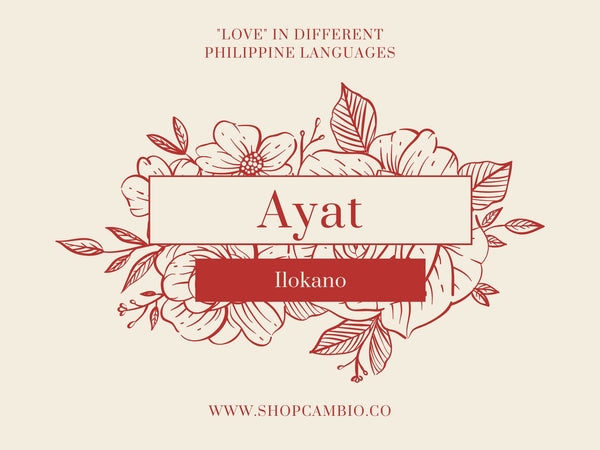I have a tricky and convoluted childhood history with language. There was a Before when all I could speak was Tagalog, followed by an After when all I could speak was English. The major life event which drew the line was when my family relocated to Thailand.
After we moved, I attended an international school where all the kids spoke English. I completely “unlearned” Filipino and learned to speak English—mostly from cartoons and comics.
I didn’t think much of it then. My family doesn’t speak much Filipino to each other, let alone a regional language. I didn’t know what I was missing when I lived abroad, but it quickly became clear when I moved back home to the Philippines.
Relearning Filipino would be necessary for my daily life—not because people couldn’t speak English in Manila. It’s spoken widely and well. Relearning Filipino became important to me so I could connect with people without feeling like there was an invisible wall between us.
Along the way, I realized there are some things best expressed in your native tongue.
I learned what “kilig” felt like when my grade school crush and I would spend hours on the phone. (There’s even a word for those long phone conversations: “telebabad”!) I feel “gigil” whenever I see a cute baby. I am very “malambing” towards those I love. These words are most potent in Filipino and hold a weight which can get lost in translation.
When you reclaim this part of your identity, your cultural roots, speaking your regional language can feel like the sincerest expression of yourself.
So, how do I tell thee “I love you”? Let us count the ways! According to the Commission on the Filipino Language, there are 130 languages spread out across the Philippine Islands each with their own unique ways of expressing love.
Here are just a few of them and their word for “love”:
1. “Sinta”, Tagalog

Tagalog is the most widely spoken Philippine language across the islands. A quarter of the population speak it as their first language, even more speak it as their second language, and it’s considered the national language—Filipino.
“Sinta” is an old-fashioned Tagalog word for love. Calling someone your “sinta” has the same charm as calling them your “beloved” or “darling.” These days, the more common endearment is “mahal” (another Tagalog word for love); but, I love the sound and depth of using the same word our great grandparents might have used once upon a time.
I’m not alone in this either. “Sinta” made a comeback in the viral OPM hit, “Mundo” by IV of Spades—the Wish 107.5 Bus performance has over 123 million views on Youtube! The crooning chorus goes, “Aking sinta, ikaw na ang tahanan at mundo (My beloved, you are my home and my world).”
2. “Ayat”, Ilokano

Ilokano is a native language spoken widely in areas of Northern Luzon. The highest concentration of speakers is in Ilocos, an expansive region hugging the northwestern coast of the Philippines. It’s comprised of four provinces: Ilocos Norte, Ilocos Sur, La Union, and Pangasinan.
A strong Spanish presence in what’s now Vigan, Ilocos Sur has laden the city with a romantic setting of cobblestone lanes, colonial-style mansions, and bubbling fountains. Contrast these visuals with the tales of heroism and liberation against Spanish rule and it’s easy to be enchanted by Ilocos.
For those of us who can’t be whisked away to Ilocos at this very moment, we can hang on to handcrafted keepsakes and heartfelt words.
If you’re planning to profess your feelings, the phrase you’re looking for is “ay-ayatenka (I love you.)” Maybe even prelude your confession with a dinner date. Cook a homey Ilocano staple, Pinakbet or Dinengdeng—both vegetable dishes sure to impress your sweetheart!
3. “Lugud”, Kapampangan

Pampanga may be dubbed the “Culinary Capital of the Philippines”, but there’s another way to a person’s heart than their stomach. It’s the old school way: poetry.
Pampanga is home to a dwindling circle of poets laureate who are dedicated to their art and the language. Literary giants like Amado Yuzon and Jose Gallardo deeply influenced local literature. Yuzon became the founder and president of the United Poets Laureate International and Gallardo wrote over 200 poems plus many more pieces of literature during his lifetime.
Both men rose from humble beginnings, worked hard to hone their craft, and were honoured as “Ari Ning Parnaso” (King of the Poets Laureate) in succession. The history of crowning a King or Queen of the Kapampangan poets reaches as far back as the 1920s and even inspired an award-winning film, “Ari: My Life With A King”!
If you’re learning your first word in Kapampangan, let it be “lugud.” It refers to an all encompassing love which isn’t limited to romantic partners; it’s expressed to all loved ones including friends and family.
You don’t need to be a wordsmith to say “Kaluguran daka (I love you.)”
4. “Gugma”, Cebuano, Waray, Hiligaynon (Ilonggo)

“Gugma” is a word for love shared by Cebuano, Waray, and Hiligaynon speakers. These three languages fall under a larger group called Visayan. It’s beautiful to think how this one word for love traverses the scattered islands of the Visayas.
Even if Cebuano, Waray, and Hiligaynon are grouped together, they reflect the diverse cultural identities and histories from which they were born. Cebuano is considered the lingua franca of the Central Visayas to Mindanao. Hiligaynon has a sing-song quality, giving its speakers a reputation for sounding very sweet and gentle.
For a love worth shouting across mountaintops and island shores, you’ll want to call out "akong gugma para kanimo (my love for you)!"
5. "Pagkamuot", Bikol

With a reputation for having some of the Philippines’ spiciest cuisine and famed for its majestic, tempestuous volcanoes (Mount Mayon, Mount Bulusan, and Mount Iriga converge here to form the Bicol Volcanic Arc), it’s no wonder the region of Bicol is known to bring on the heat. Can we say the same for the people of the region? (Wink, wink.) We’ll leave the testing to you!
“Pagkamuot” is the word you’re looking for when you want to romance a Bicolano.
Important to note, though, if things get lost in translation: the Bicol region is diverse with numerous Bikol languages. The major groups are Coastal Bikol, Inland Bikol, and Northern Catanduanes Bikol with even more languages and dialects under each one. According to The Bikol Initiative, there are some areas where people from adjacent towns could speak to each other in their Bikol language and not understand each other. The most widely spoken version is Central Bikol.
6. “Amor”, Chavacano

You may recognize this word from your basic Spanish classes.
Chavacano or Chabacano is a creole language which borrows heavily from Spanish. In Zamboanga City, Mindanao where Chavacano is widely spoken, you’ll hear the same rolling R’s and lilting Ñ’s we all find so romantic in Español! Other varieties are also spoken in Cavite all the way in Luzon.
What sets Chavacano apart from Español, making it entirely our own, is the FIlipino touch—sentence structure!
7. "Lasa", Tausug

Tausug is a name for both the group of people and the language spoken in the Sulu Archipelago, a cluster of islands in the southern seas of the Philippines. Inspired by the tides flowing south to the Celebes Sea, Tausug means “the people of the current.”
The echoes of their past resistance against Spanish conquistadors and the Marcos dictatorship have solidified the Tausug as fierce and brave people. Sound like someone you know and love?
Before you utter the magic word, “lasa”, set the mood. Put on the smooth melodies of Sitti, a famous Filipina bossa nova singer—who is also of Tausug descent. Sway to her serenade, “Para Sa Akin”, and let the moment come!
Say it, Wear it.

Want to go the extra mile for love? Say it loud and proud when you #WearYourHeritage.
Love can come in many forms and be expressed in infinite ways. One of our favorite ways at Cambio & Co. is by wearing Filipino jewelry to honor our loved ones.
Picture this: your sweetheart opens a gift from their ancestral province of Ilocos Sur, while you say "Ay-ayatenka (I love you)". 'Di ba, nakakakilig - wouldn't that make you swoon?
You can browse Cambio & Co.'s entire jewelry collection by region of the Philippines for the perfect gift for your Sinta.
Cover photo by Ariana del Mundo for Sinta & Co. (Cambio & Co.'s sister wedding brand), featuring the Love & Blossoms Filipino Unity Coins.
Nicolette Bautista

Nicolette is a Manila-based creative freelancer and Cambio & Co's Community Storyteller. She's written on the digital space about mom-and-pop's, small businesses, and social enterprises. In the pursuit of her eclectic interests, Nicolette has a broad portfolio including short videos, album art, and storybook illustrations! Find her on Instagram @of_nicolette and ofnicolette.wordpress.com



Enjoyed the article. Thanks.
A geographical point—-the Ilocos region is composed of Ilocos Norte/Sur, Abra, and La Union.
Pangasinan is a Central Plain of Luzon province, and Ilocano is mostly spoken in eastern Pangasinan; Pangasinense in the western part.
The Pangasinense word for love is ‘Aro’. “Inar-aro taka” translates to “I love you very much”.
Keep well! G’day from Sydney! 24/2/24
Thank you for this powerful and deep sharing. As an American who had near zero success learning other languages, I decided one way to show my Cebuana loved one that I really cared, was to take on learning Cebuano. She was raised in a way that forced her to learn 4 languages, Tagalog, Cebuano, English and Spanish, sometimes each pure, often mixed into Ciblish, Taglish or all four. I found Pimsleur Tagalog and it allowed me to learn 50x more Tagalog than Cebuano, but your article hit the spot as the love and other common phrases were critical enough to force me to learn them in Cebuano. Gihigugma ko kaayo ikow. Gimingow, ko nimo. Maayong buntang Mahal. Maayong gabii Mahal.
A thousand times now I have amused and astounded telephone support workers when I easily recognize the Manila accent and converse in Tagalog. When in the Philippines the amusement is often over the top as strangers act like they have never seen an American who speaks their language and they ask why would I bother? The same reasons you gave, it allows me to honor you, your country, your wonderful people, to show you respect. It was worth every one of the many hours of effort.
Leave a comment